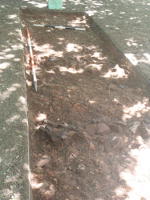10 Jul 2015
Festival Of Archaeology 2015 - Cedars Park - Day 1

The first day of our Festival of British Archaeology digs got off to a great start today -- We've opened two trenches continuing our exploration of what we think is a large 'loggia' structure, which would have been attached to the grand gardens of James I's Theobalds Palace.
Trench 1 was opened slightly overlapping last year's trenches, so it was no surprise when we immediately uncovered the loggia wall. This trench is targeted on a brick projection attached to the main loggia wall which we only examined partly last year. We've already uncovered the top of this feature and have found that it is in fact two walls projecting side by side at ninety degrees from the main loggia wall.
Since we've only seen the top of these walls, it's too soon to say whether they are part of the main loggia colonnade, or perhaps part of some sort of internal feature -- we'll hopefully get a better idea when we excavate more tomorrow.

Meanwhile, Trench 2 was opened a small distance to the west, and offset to look at the ornamental canal that we think bounded the loggia.
This trench came straight down onto a distinct cobbled path or road surface, which seems to run alongside the loggia wall, and was bounded along its north edge by two peculiar lines of rubble. Pottery sherds within the rubble show that the lines and the path date to the nineteenth century -- we think the rubble was placed as a crude kerb at the side of the path, with the remains of the loggia wall (which was probably above ground at the time) forming the other side.
Crucially, the rubble itself is of a much earlier date, and composed almost exclusively of relatively high status ceramic building material, including moulded and drip-glazed bricks, and at least two types of floor tiles, perhaps once part of a chequered pattern floor.
This is the best evidence of the interior construction of the loggia so far -- hopefully some of this material has survived elsewhere in-situ.
We also hope that the ornamental canal survives intact beneath the road surface -- digging down under this level is another job for tomorrow.